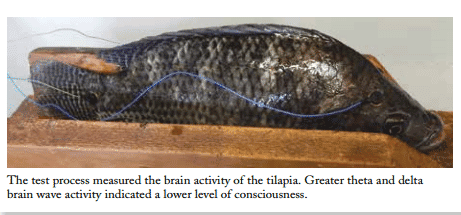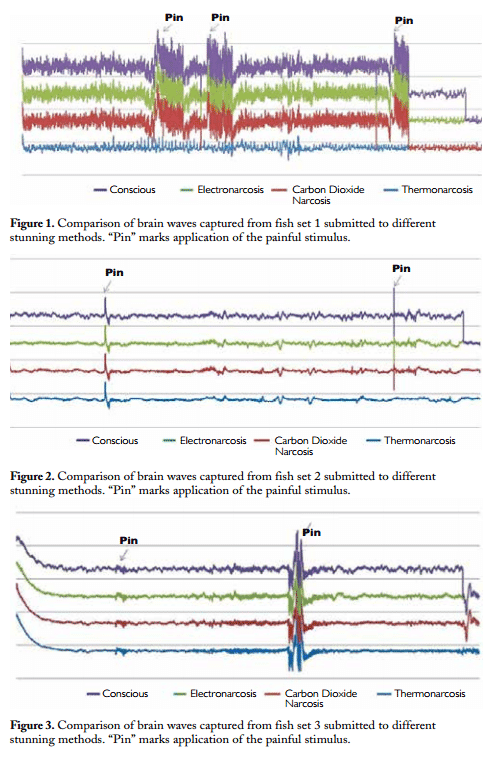About 15 years ago, fish were commonly thought to not feel pain. Part of the scientific community also shared the same opinion. After 2002, however, this idea began to change with the publication of studies attesting that fish have sensory pathways that allow them to feel pain.
Two years later, behavioral studies showed that fish have memory, indicating they have the neurological substrate and ability to sense and suffering. The current consensus is that fish have the necessary brain structure to enable them to feel fear and pain. The scientific proof that fish are sentient creatures created the need to rethink aquaculture practices to account for fish welfare.
Stunning Methods
In Brazil, fish are usually stunned and killed by immersion in ice water or ice asphyxia, methods that have been proven not to cause immediate loss of brain function and can negatively impact the quality of the flesh.
The low temperatures caused by immersion in ice water decrease metabolism and immobilize fish. Carbon dioxide narcosis and electronarcosis are stunning methods used on bovines, swine and poultry that have also been applied in the fishing industry.
But does immobility clarify whether the fish is numb or just paralyzed? Many studies have attested to the effectiveness of stunning methods based only on behavioral observations. If the fish had no movement or behavioral reaction to a painful stimulus, the stunning method was considered effective.
It was assumed that a fish in that condition would not be able to feel pain or would feel it less intensely. However, if immobilization occurs without loss of conscience, the fish feel without any mitigation the effects from slaughtering or even evisceration. The physiological response to the pain is to release oxidizing substances that negatively impact the quality of the flesh, not to mention the implications regarding animal welfare.
EEG Evaluation
In research, the authors aimed to verify the effectiveness of thermonarcosis, carbon dioxide (C.O.2 ) narcosis and electronarcosis by assessing the electrical brain activity of fish, captured through an electroencephalograph.
The brain activity recorded on an encephalogram (EEG) can be classified in delta (0-4 Hz), theta (4-7 Hz), alpha (8-13 Hz) and beta (over 13 Hz) frequencies. A predominance of alpha and beta wave activity indicates that an animal is conscious, while predominantly theta and delta waves indicate the animal is under some degree of stunning. Consciousness is defined as the ability to perceive the world and one’s own body (in this case, through pain), while unconsciousness is a state of non-responsive dormancy.
In the thermonarcosis treatment, the fish were immersed in ice water of approximately 1° C temperature at a 1:1 ratio until no eye rotation, opercular movement or reaction to a painful stimulus was observed. These reactions were no longer observed after an average of 22 ± 3 minutes.
In C.O.2 narcosis, the water was injected with carbon dioxide to the saturation point while monitoring the solution pH. The solution reached the saturation point when the pH stabilized. Subsequently, fish were immersed until no eye rotation, opercular movement or behavioral response to a painful stimulus was observed. Reactions were no longer observed after an average of 63 ± 13 minutes. The electronarcosis method consisted of applying 154 volts, with 8 amperes for 180 seconds.
The voltage and duration were defined by previous experiments, which determined the shortest exposure time and voltage required for the fish to lose eye rotation, opercular movements and behavioral response to a painful stimulus.
The EEGs were performed individually just after the fish were considered stunned by one of the aforementioned criteria. During the EEG analysis, the application of the painful stimulus – insertion of a pin in a caudal-cranial direction on the lateral line – to verify the electrical brain response was synchronized among treatments to facilitate data comparison.
Results
This study examined the EEG results for 40 Oreochromis species tilapia of 525 ± 152 g average weight and 31 ± 3 cm average length. The tilapia were distributed in four groups. In the control group, fish did not undergo any stunning method. Fish in the other groups were treated by thermonarcosis, carbon dioxide (C.O.2 ) narcosis or electronarcosis.
Due to the high variability of the brain waves of each animal and the different response of each individual to a stunning method, there was necessarily a large number of repetitions: 10 for each treatment. Figures 1, 2, and 3 show the EEGs of one conscious fish from the control group compared to that of one fish from each of the other three groups. No fish was stunned more than once.
It is noteworthy that, in general, the wave amplitude recorded by the EEG in thermonarcosis was shorter than in the other treatments, as seen in Figure 1. On the other hand, electronarcosis showed higher wave amplitude (Figures 1 and 3) in most cases. C.O.2 narcosis yielded results similar to those for electronarcosis.
The higher wave amplitudes captured by the EEGs reflected more activity by the alpha and beta waves, indicating greater brain activity and a state of consciousness. Likewise, the lower the amplitude of signal variation was – signifying more activity of theta and delta waves – the lower the brain activity and according consciousness were.
Responses
The sudden increases of wave amplitude observed in the figures corresponded to the insertion of the pin. The sudden increase of wave amplitude is seen in all treatments, but with less intensity in thermonarcosis, as shown in Figures 1 and 2.
This fact indicated that even when fish brain activity was considered lower, the brains of “stunned” fish, which showed higher low-frequency wave activity, were still capable of feeling the stimulus. The way the brain of the fish processes the neurological signal received via afferent and if it realizes it as pain needs further research.
The data obtained in this experiment seemed to indicate that even if the fish showed more theta and delta wave activity during the painful stimulus, there was a superficialization of consciousness, with the sudden increase of alpha and beta activity that indicates regaining of consciousness and thus capacity to feel pain with no mitigation.
It would be as if the fish were in a torpor state, but ready to react to a threat, such as a painful stimulus, when necessary.
Perspectives
The results obtained in this study showed that thermonarcosis was the most effective stunning method for tilapia, promoting more activity of theta and delta waves. Nevertheless, it is not possible to state that thermonarcosis resulted in fully effective stunning due to the occurrence of a sudden increase of wave amplitude when the painful stimulus was applied, which indicated regaining of consciousness.
This study is just a first step towards elucidating how, when needed, a heterothermic animal, which can have its metabolic rate significantly reduced, reacts physiologically and neurologically to each stunning method studied and how this can interfere with its capacity to feel pain.
February 2015






